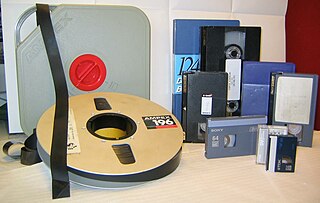
The VHS is a standard for consumer-level analog video recording on tape cassettes, introduced in 1976 by the Victor Company of Japan (JVC). It was the dominant home video format throughout the tape media period in the late 1970s, 1980s, and 1990s.

Videotape is magnetic tape used for storing video and usually sound in addition. Information stored can be in the form of either an analog or digital signal. Videotape is used in both video tape recorders (VTRs) and, more commonly, videocassette recorders (VCRs) and camcorders. Videotapes have also been used for storing scientific or medical data, such as the data produced by an electrocardiogram.

S-VHS (スーパー・ヴィエイチエス), the common initialism for Super VHS, is an improved version of the VHS standard for consumer-level video recording. Victor Company of Japan introduced S-VHS in Japan in April 1987, with their JVC-branded HR-S7000 VCR, and in certain overseas markets soon afterward. By the end of 1987, the first S-VHS VCR models from other competitors included the Hitachi VT-2700A, Mitsubishi HS-423UR, Panasonic PV-S4764, RCA VPT-695HF, and Toshiba SV-950. It has been standardized as IEC 60774-3 and IEC 60774-4.

A video rental shop/store is a physical retail business that rents home videos such as movies, prerecorded TV shows, video game discs and other media content. Typically, a rental shop conducts business with customers under conditions and terms agreed upon in a rental agreement or contract, which may be implied, explicit, or written. Many video rental stores also sell previously viewed movies and/or new, unopened movies.
Direct-to-video or straight-to-video refers to the release of a film, television series, short or special to the public immediately on home video formats rather than an initial theatrical release or television premiere. This distribution strategy was prevalent before streaming platforms came to dominate the TV and movie distribution markets.
Original programming is a term used for in-house television, film or web series productions to which the exclusive domestic and, if the originating service operates non-domestic versions of the service outside of their home country, international broadcast rights are held by traditional and over-the-top content providers. The term was coined by HBO in 1983 when the premium service began producing its slate of in-house series and film productions. HBO initially branded the original series on the network under "HBOriginal" until 1986, and by 1993, the "originals" term had expanded to encompass most of its original productions. The term eventually expanded into use by various cable-originated television networks to identify their in-house productions. It also advertises them as being distinct from the acquired content offered to fill out the remainder of their programming schedule.

Flix is an American premium cable and satellite television network owned by Showtime Networks, a subsidiary of Paramount Global operated through its Paramount Media Networks division. Its programming consists solely of theatrically released motion pictures released from the 1970s to the present day, interspersed with some films from the 1950s and 1960s.

The Movie Channel (TMC) is an American premium television network owned by Showtime Networks, a subsidiary of Paramount Global operated through its Paramount Media Networks division. The network's programming mainly features first-run theatrically released and independently produced motion pictures, and during promotional breaks between films, special behind-the-scenes features and movie trivia.
Pay television, also known as subscription television, premium television or, when referring to an individual service, a premium channel, refers to subscription-based television services, usually provided by multichannel television providers, but also increasingly via digital terrestrial and streaming television. In the United States, subscription television began in the late 1970s and early 1980s in the form of encrypted analog over-the-air broadcast television which could be decrypted with special equipment. The concept rapidly expanded through the multi-channel transition and into the post-network era. Other parts of the world beyond the United States, such as France and Latin America have also offered encrypted analog terrestrial signals available for subscription.

The videotape format war was a period of competition or "format war" of incompatible models of consumer-level analog video videocassette and video cassette recorders (VCR) in the late 1970s and the 1980s, mainly involving the Betamax and Video Home System (VHS) formats. VHS ultimately emerged as the preeminent format.
A film distributor is a person responsible for the marketing of a film. The distribution company may be the same as, or different from, the production company. Distribution deals are an important part of financing a film.
Film finance is an aspect of film production that occurs during the development stage prior to pre-production, and is concerned with determining the potential value of a proposed film.
Film distribution, also called film exhibition or film distribution and exhibition, is the process of making a movie available for viewing to an audience. This is normally the task of a professional film distributor, who would determine the marketing and release strategy for the film, the media by which a film is to be exhibited or made available for viewing and other matters. The film may be exhibited directly to the public either through a movie theater or television, or personal home viewing. For commercial projects, film distribution is usually accompanied by film promotion.

Home Box Office (HBO) is an American pay television network, which is the flagship property of namesake parent-subsidiary Home Box Office, Inc., itself a unit owned by Warner Bros. Discovery. The overall Home Box Office business unit is based at Warner Bros. Discovery's corporate headquarters inside 30 Hudson Yards in Manhattan. Programming featured on the network consists primarily of theatrically released motion pictures and original television programs as well as made-for-cable movies, documentaries, occasional comedy, and concert specials, and periodic interstitial programs.
The Financial Interest and Syndication Rules, widely known as the fin-syn rules, were a set of United States rules imposed by the Federal Communications Commission (FCC) in 1970 on the television industry.
Film commissions are quasi-governmental, non-profit, public organizations that attract motion media production crews to shoot on location in their respective localities, and offer support so that productions can accomplish their work smoothly.

Home video is recorded media sold or rented for home viewing. The term originates from the VHS and Betamax era, when the predominant medium was videotapes, but has carried over to optical disc formats such as DVD and Blu-ray. In a different usage, "home video" refers to amateur video recordings, also known as home movies.

Funai Electric Co., Ltd. is a Japanese consumer electronics company headquartered in Daitō, Osaka. Apart from producing its own branded electronic products, it is also an OEM providing assembled televisions and video players/recorders to major corporations such as Sharp, Toshiba, Denon, and others. Funai supplies inkjet printer hardware technology to Dell and Lexmark, and produces printers under the Kodak name.

A videocassette recorder (VCR) or video recorder is an electromechanical device that records analog audio and analog video from broadcast television or other AV sources and can play back the recording after rewinding. The use of a VCR to record a television program to play back at a more convenient time is commonly referred to as time shifting. VCRs can also play back prerecorded tapes, which were widely available for purchase and rental starting in the 80s and 90s, most popularly in the VHS videocassette format. Blank tapes were sold to make recordings.
A script market is the system in which a screenwriter and producer engage in the buying and selling of a script for the film and television industries. The process of selling a script may begin with the pitch, however since the end of the 1980s the ability to pitch a film to producers has greatly depended on the notoriety of the screenwriter. One reason attributed to this effect is that studios are looking for the next big hit, but scared to take a chance on a script that doesn’t meet a pre-established formula guaranteed to make money since no one knows what will work. The majority of scripts are read by studio interns and others, who give the scripts a “consider”, “pass”, or “recommend” status, with most scripts receiving a “pass” rating. However, an agent who's signed the Artists-Managers Agreement drawn up by the Writers Guild of America can submit scripts to producers directly. Agents try to create buzz in the script market using spec script. With everyone in the entertainment industry trying to pursue the million-dollar dream, and Hollywood so desperate for new material ideas, the script market functions and business practices have been pursued in the spec script manner.










